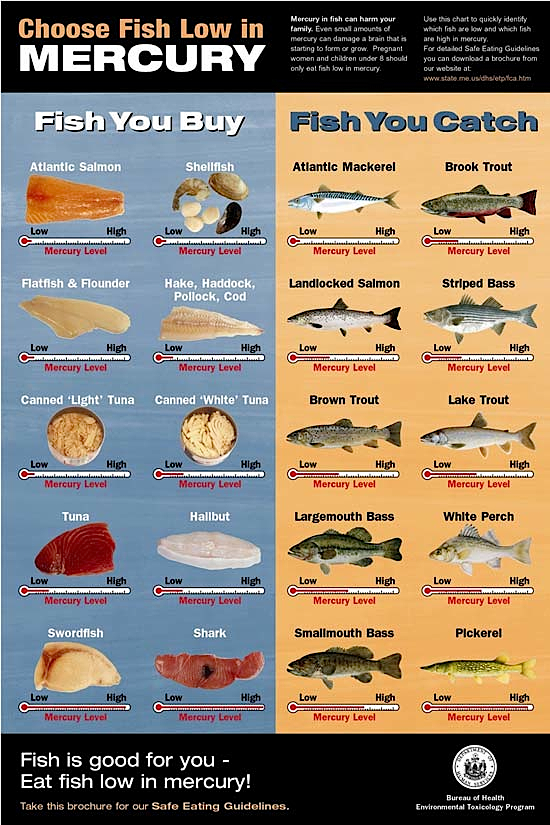
 BY ELIZABETH FIEND LIVING EDITOR Subway’s Tuna sandwich is advertised as dolphin-safe but they fail to mention it comes with a side order of heavy metal — mercury, to be exact. Not just hoagies, sushi too. Shocking news outta Manhattan recently. How much mercury did you say was in that sushi? Yikes, just eating two or three pieces a week of bluefin tuna sushi could be a health hazard for an adult. There are dangerous levels of mercury in marlin, shark, and swordfish, too. Tuna is the fish most often consumed by Americans, so this is the vehicle for most of our mercury exposure. But even the fish you catch yourself, in nearby streams, rivers and lakes out on those fishing trips with your buddies is contaminated with mercury.
BY ELIZABETH FIEND LIVING EDITOR Subway’s Tuna sandwich is advertised as dolphin-safe but they fail to mention it comes with a side order of heavy metal — mercury, to be exact. Not just hoagies, sushi too. Shocking news outta Manhattan recently. How much mercury did you say was in that sushi? Yikes, just eating two or three pieces a week of bluefin tuna sushi could be a health hazard for an adult. There are dangerous levels of mercury in marlin, shark, and swordfish, too. Tuna is the fish most often consumed by Americans, so this is the vehicle for most of our mercury exposure. But even the fish you catch yourself, in nearby streams, rivers and lakes out on those fishing trips with your buddies is contaminated with mercury.
Mercury is dangerous to kids, especially when they’re still in the womb. A powerful neurotoxin, mercury can impair a child’s ability to do just about everything – walk, talk, read, write. And the effects are permanent. Currently, one in six American babies are born with mercury levels exceeding the Environmental Protection Agency’s (EPA) safe limit. It’s not good for adults, either, recent studies have shown. High mercury intake has been associated with an increased risk of heart disease and neurological problems in grownups. But where is the mercury coming from?
a child’s ability to do just about everything – walk, talk, read, write. And the effects are permanent. Currently, one in six American babies are born with mercury levels exceeding the Environmental Protection Agency’s (EPA) safe limit. It’s not good for adults, either, recent studies have shown. High mercury intake has been associated with an increased risk of heart disease and neurological problems in grownups. But where is the mercury coming from?
From opening the hood of your car.
Say what? Yeah, freaky.
You know the switch that turns on the light when you open the trunk of your car? It’s got mercury in it. When your car is scrapped, so the metal can be reused, the mercury is released into the atmosphere. In the U.S. alone an unbelievable 10 to 12 tons of mercury each year comes from these mercury switches in cars. So, like, recycling sucks? Or maybe it’s the car industry that sucks for using mercury-based switches in the first place?
I wouldn’t lie to you. Lye production is another huge global source of mercury pollution.
Mercury is used to convert salt into lye (chlorine gas and caustic soda) which is then used in manufacturing detergents, plastics (especially PVC) and paper. These chlor-alkali plants have been polluting the world for years. And with the recent housing boom, PVC production has skyrocketed.
But the number one reason for mercury finding its way into fish in the U.S. is coal.
Mercury is naturally found in coal. So when coal-fired factories and electricity-making power stations burn coal, mercury is released into the atmosphere — 48 tons of it each year in the U.S.
After being released from smoke stacks, the mercury particles float around the atmosphere for about three years. Finally the particles fall to the ground. When they fall into oceans, lakes, streams and rivers, the mercury becomes the even more toxic organometallic compound methlymercury.
Once in our waterways, methlymercury moves up through the aquatic food chain and then into our stomachs when we eat fish, especially fatty kinds. Mercury is easily absorbed but slowly excreted from the human intestinal wall. Mercury can remain in our blood for over a year after we ingest it.
The fix is in.
There are fixes for all these mercury polluters. All that’s lacking is the will to fix them, especially on a global level.
Mercury-free technology for chlor-alkali manufacturing is already happening in new plants, and some older ones have converted. Every chlor-alkali plant could be mercury-free, if the owners cared.
We have to face it: Coal is a limited natural resource. It’s dirty, and not the way to go to combat the energy crisis. Ya hear me President Bush? Stop with the coal already.
Unfortunately, mercury can float in the air for thousands of miles. China has plans in the works to build a new coal plant each week for the next 560 weeks (I’ll do the math for you, that’s a new plant every week for the next 10 years). And with its booming economy, China is way into PVC, using it and producing it.
Don’t look in the trunk.
 Following intense public pressure (go consumers!) the automobile industry agreed to stop using mercury-based switches in 2003. But there are about 150 tons of mercury sitting around in pre-2003 cars. Sooner or later these cars too will be scrapped and the mercury released.
Following intense public pressure (go consumers!) the automobile industry agreed to stop using mercury-based switches in 2003. But there are about 150 tons of mercury sitting around in pre-2003 cars. Sooner or later these cars too will be scrapped and the mercury released.
The fix around these light switches is to remove them before the car is melted down (it takes about a minute per car to remove the switches) and pass the cost on to the automobile makers who installed the switches in the first place.
Some states have already passed legislation requiring the removal of mercury-based light switches from automobile scrap, but the EPA has yet to introduce nationwide standards. What’s happening in Washington?
The EPA is a basically schizophrenic. Legislation was already in place to guard against mercury pollution, but in 2004 the Bush administration weakened and delayed efforts to clean up mercury pollution by redefining mercury emissions as run-of-the-mill pollutants, not hazardous pollutants.
Call in the Spin Doctor.
The EPA called this recatagorizing of mercury from hazardous to ordinary the Clean Air Mercury Rule (CAIR). Does that take balls or what? The CAIR plan was to create a cap-and-trade program where coal-fired plants could swap rights to emit mercury with other factories and power plants.
The plans was so stupid, and so obviously harmful to the environment, and to creatures that eat fish — like the American Bald Eagle — that a bunch of states, consumer, medical and environmental advocacy groups, not to mention a few Native American Indian tribes, had to sue the federal government.
A victory!
I know, it seems unbelievable, but a federal court just ruled that the EPA must rework its kooky scheme for mercury polluters. The court ruled that the EPA actually violated its own Clean Air Act when it removed mercury from the list of toxic substances, which also includes lead, nickel and arsenic.
The new ruling means that coal-fired plants and plants making electricity from coal will have to actually curb mercury emissions. They’ll have to install mercury-reduction equipment on their plants rather than be allowed to pollute and trade pollution-shares with a less polluting plant.
Unfortunately, this victory has thrown regulation into a free fall. New rules must be drafted, then enacted. It could take years. In the meantime, states can set their own limits, and hopefully they’ll set strict ones. Globally, we’re in deep trouble unless we get some sensible lawmakers.
What can you do?
To see the FDA guidelines for fish consumption: http://www.cfsan.fda.gov/~frf/sea-mehg.html As you’ll note, the data is years old.
Lastly, think of this way: Eating fish isn’t just bad for you, it’s bad for the fish too. Commercial over-fishing and lack of governmental regulation have pushed many fish populations to the brink of collapse.
Sources and For More Information
Natural Resources Defense Council:
http://www.nrdc.org/health/effects/mercury/sources.asp
News from Harvard
http://focus.hms.harvard.edu/2004/Feb20_2004/environmental_health.html
Common Dreams.org:
http://www.commondreams.org/news2008/0206-21.htm
http://www.commondreams.org/news2008/0208-08.htm
Reuters:
http://www.reuters.com/article/environmentNews/idUSN0847678520080208?sp=true
International Herald Tribune:
http://www.iht.com/articles/2008/01/22/america/fish.php
EPA:
http://www.epa.gov/mercuryrule/basic.htm
FDA:
http://www.fda.gov/fdac/features/2004/304_fish.html
ABOUT THIS COLUMN: At no time in recorded history have we possessed so much knowledge about health and nutrition, or had such vast and effective means for disseminating that knowledge. Yet for all that, we essentially live in a high-tech Dark Age, with most of the global population ignorant or confused about the basic facts of their own biology. How did this happen? Well, that alone is a whole six-part miniseries, and this ain’t the Discovery Channel. Suffice to say that the bottom line of many a multi-national corporation depends on that ignorance, and vast sums of money are expended to keep us fat, dumb and happy. But mostly fat. There was a time when newspapers saw it as their duty to truth squad the debates over health, science and the environment, but that’s a luxury most papers can no longer afford — not when there are gossip columnists to be hired! To help remedy this violation of the public’s right to know, Phawker publishes the JUNK SCIENCE column by Elizabeth Fiend, beloved host of the BiG TeA PaRtY. Every week, Miss Fiend connects the dots to reveal a constellation of scientific facts that have been hiding in plain sight, scattered across the cold, vast reaches of the Internet. With a background in punk rock and underground comics, and a long career as a library researcher, Miss Fiend doesn’t pretend to be a scientist or an expert. She does, however, know how scientific facts become diluted by corporate-sponsored non-facts, and every week she separates the smoke from the mirrors. Why? Because she loves you.
